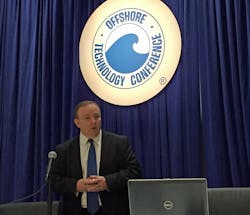If there’s a different vibe playing out at the Offshore Technology Conference (OTC) this year in Houston, it’s that oil producers have become relatively resigned to the idea that they’re now working in a paradigm of $50/barrel oil. “There’s a realization that the price is going to be down for the foreseeable future,” commented Steve Sonnenberg, chairman of Emerson Automation Solutions, during a press briefing at the show. “They’re making money now at $50 to $60 a barrel. That was unheard of several years ago.”
In addition to the growing criticality of automation within that shift, there’s a growing emphasis on keeping existing wells producing and profitable. “Compensating for output declines absorbs more than 80 percent of upstream investment,” said Peter Zornio, chief technology officer for Emerson Automation Solutions. “At $50 a barrel, there’s a lot more focus on getting more out of what you have.”
Extracting greater value from existing assets and reducing the rate of field decline is the impetus behind the next-generation artificial lift optimization software that Emerson announced this week. With the Dynamic Lift Optimization (DLO) software, a typical site operating multiple wells can achieve a 10 percent production improvement by responding immediately to changes in field operation, continually reallocating available lift resources.
Wells go through a typical lifespan that sees them producing great at first, but then the pressure falls off over time. As the natural pressure drops, oil producers use some form of artificial lift to help the oil rise to the surface. But how much artificial lift a given well needs can be limited by a number of factors. With gas lift optimization, for example, one consideration is allocating the amount of available gas to the various wells in the most optimal way, explained Lou Heavner, a consultant for Emerson. “You have to shift the lift gas from well to well to optimize production,” he said. “The optimizer is always seeking the best way to do that.”
Ideally, oil producers will be able to apply artificial lift to the wells that will give them the best production, Zornio explained. “There are a number of software packages on the market that let you look at individual wells in a snapshot manner, and boost production on individual wells,” he said. “What we’ve introduced is a closed-loop package that does that in real time.”
DLO software dynamically adjusts lift gas flows or electric submersible pump (ESP) speed based on the most recent well test curves. Once configured, the application optimally allocates the available lifting power to the wells to maximize production, at the same time adjusting to changing conditions such as wells coming on or off or compressor trips. By contrast, traditional gas lift adjustments are typically handled manually and infrequently, resulting in missed opportunities and lower field performance.
Earlier versions of the software have helped oil and gas producers generate millions of dollars per year in increased production. The new version—with capabilities related to the Industrial Internet of Things (IIoT)—is easier to implement and allows a cloud-based infrastructure. Production engineers can safely and securely access crucial field optimization data from any location with an Internet connection.
The software also now uses the OSIsoft PI System, a highly scalable open data infrastructure and historian that provides a common data architecture from the plant floor to the enterprise level, making information available wherever needed for better business decisions.
With the DLO software working dynamically, Emerson’s multiphase meter is effective for feeding into that capability. The three-phase flowmeter is an alternative to test separators, which take typically at least a day to test the contents of just one well, meaning getting results back on a field could take a week or two.
“What you would really like to have is a continuous knowledge all the time about what’s coming out of that oil well,” Zornio said. “The three-phase flowmeter supplies real-time, continuous well data. It improves reservoir optimization, makes marginal fields more viable, and reduces the surface facility footprint.”
Though the technology for doing multiphase metering has been around quite a while, Zornio said, it’s been expensive. Emerson has, over time, been able to get the Roxar MPFM 2600 multiphase flowmeter platform down to a price point that makes it more applicable to every well, he added. “It lets you do a much better job of controlling and optimizing production across the oil field.”
With multiphase metering and lift optimization software, an example customer with 38 wells on five different platforms was able to achieve a 10 percent production increase. That amounts to $160 million a year of additional production for them.
“It is critical to direct lift resources precisely to the highest-value wells, and Emerson’s optimization solution has proven to increase oil recovery rates and slow well decline rates,” said Jose Jimenez, director for Emerson Automation Solutions’ global oil and gas industry business. “The new software platform lowers implementation cost significantly.”
About the Author
Aaron Hand
Editor-in-Chief, ProFood World

Leaders relevant to this article:
